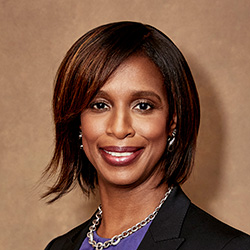How Amazon Moved Faster Than Ever During the Pandemic
In the Farley Center’s Fireside Chat, Amazon VP Alicia Boler Davis said machine learning, AI, and even improvisation were critical to success
Almost one year later, it’s hard to remember the empty shelves and toilet paper shortages triggered by the first COVID-19 lockdowns. The initial shock to supply chains has all but worn off, and people have adapted to quarantine life with alternative ways to stock up, including a flood of online shopping.
Much of that happens on Amazon. Already one of the world’s largest online retailers, the sudden surge in online shopping established Amazon as a key provider for consumer lockdown needs during the pandemic. And it showed: total US e-commerce sales in April and May 2020 made up 22 percent of all retail sales compared with 11 percent in 2019, according to a Mastercard report. Consumer spending on Amazon between May and July shot up 60 percent compared with the same timeframe in 2019, according to Facteus.
 But will Amazon’s success outlast the pandemic? Alicia Boler Davis (’91), the company’s vice president of global customer fulfillment, argues Amazon is poised to emerge from the pandemic stronger than ever.
But will Amazon’s success outlast the pandemic? Alicia Boler Davis (’91), the company’s vice president of global customer fulfillment, argues Amazon is poised to emerge from the pandemic stronger than ever.
During the February 1 Fireside Chat event hosted by the Farley Center for Entrepreneurship and Innovation, Boler Davis shared some of the challenges Amazon faced in the early days of the pandemic and how the company’s fast-moving culture of innovation allowed it to adapt its hard-hit supply chain and logistics methods, accelerate shared learning, and implement solutions faster than before. Vijay Vaitheeswaran, Farley Fellow and US business editor for The Economist, hosted the event.
Turning to technology during the pandemic
Machine learning (ML) and artificial intelligence (AI) technologies played a crucial role in Amazon’s success, argued Boler Davis.
“I couldn’t imagine not having AI and ML capabilities at Amazon during the pandemic because of the number of variables that were changing at any given time,” she said.
Using AI and ML to improve supply chain management is a relatively new concept.
“The foundational elements of supply chain are true, but at a company like Amazon where our demand is variable at any given hour, we’re already leveraging machine learning forecasts that help us plan ahead,” Boler Davis said. During COVID-19, different cities conducting different styles of lockdowns affect spending patterns and purchases. “AI and ML have even helped us anticipate when customers are going to place another order based on their buying patterns, and what that order may be. Having machine learning models running in the background gave us different scenarios that allowed us to plan,” Boler Davis added.
Innovation happens from the ground up — and the top down
 Doing business during “the eye of the storm” presented challenges and opportunities for Amazon. “Not only was Amazon enduring the worst global economic crisis in decades as well as the human impact on the workforce, but it also served as a vital service for many people who were shut in receiving goods. At the same time, you had many operational challenges, as well as ensuring the health of your own employees,” Vaitheeswaran said.
Doing business during “the eye of the storm” presented challenges and opportunities for Amazon. “Not only was Amazon enduring the worst global economic crisis in decades as well as the human impact on the workforce, but it also served as a vital service for many people who were shut in receiving goods. At the same time, you had many operational challenges, as well as ensuring the health of your own employees,” Vaitheeswaran said.
Employee safety has always been Amazon’s “north star,” said Boler Davis. “We needed to ensure the environments where our employees were working were safe. Being a company that is really focused on innovation, we made over 150 process changes globally to make sure we were following the latest health guidance including thermal screening, and starting our own COVID-19 testing capabilities for our employees. We also leveraged our tech teams to implement machine learning and AI tools that helped people be aware when they were less than six feet apart, and make corrections in real time.”
Amazon also learned to operate effectively while virtual, especially in the pandemic, where certain geographies experienced something like quarantine before others, making it important to share learnings. “Video has allowed us to do virtual innovation sharing with teams around the globe so everyone can share ideas in real time, whether it’s a new robotics solution or better ways to encourage employee participation,” Boler Davis added.
To this end, Amazon also learned from the resourcefulness of its global workforce. In developing countries, Boler Davis said, fulfillment center workers came up with creative, fast, low-cost solutions for maintaining social distancing — such as plexiglass and shower curtain dividers. “Keep it simple, and you’re still able to innovate. Sometimes you have to come up with things that are available at your fingertips today,” Boler Davis said.
“This is how innovation happens,” Vaitheeswaran said. “By busting down silos where knowledge may have been trapped in one area, you can accelerate learning loops and disperse ideas more widely across cultures.”
“It’s been widely observed that in times of crises, weak companies fail, strong companies survive, but the greatest companies thrive,” Vaitheeswaran added.
Boler Davis on breaking through glass ceilings
Boler Davis is no stranger to innovation. From an early age, she considered herself a tinkerer. She received a bachelor’s degree in chemical engineering at Northwestern, a master’s in engineering science from Rensselaer Polytechnic Institute, an MBA from Indiana University, and an honorary doctorate of engineering from Rensselaer. Before joining Amazon, she spent nearly 25 years at General Motors, most recently as executive vice president of global manufacturing and labor relations. In 2018 Alicia was named one of the Most Powerful Female Engineers by Business Insider, and in 2020 was named one of Fortune’s Most Powerful Women, and in 2021, CNBC Make It named her one of the 23 black leaders who are shaping history today.
“As black woman engineer, I have a sense of responsibility in my role,” Boler Davis said. “I am also acutely aware that my personal success is not common enough, nor would it be possible without lots of support. There’s been good progress made, but we have much more work to do.”
Businesses need to hold leadership accountable, she added. “You have to look at the facts and not shy away from data, and then take action. Make changes.”
An MIT-trained engineer himself, Vaitheeswaran asked Boler Davis about her engineering foundation at Northwestern and advice she has for students.
“My engineering background has far exceeded my expectations,” said Boler Davis, who serves on the McCormick Advisory Council and Northwestern’s Board of Trustees. “Getting through the engineering curriculum at Northwestern gave me incredible confidence. I truly believed I could do anything when I left Northwestern.”
To students, she said, “Don’t be afraid of failure. I’ve grown the most when I’ve stumbled and had to figure things out. I’m not perfect. Nobody is. And that’s okay. Enjoy the process and take chances.”
Join the Farley Center for Entrepreneurship and Innovation for upcoming events. Learn more.